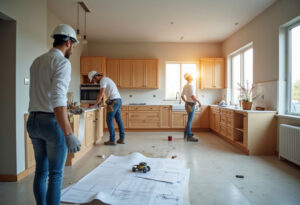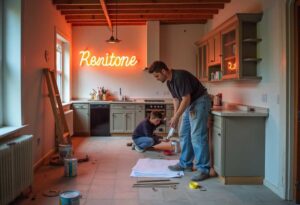Typical inspection stages:
Building a home addition is a major investment — one that can significantly enhance your lifestyle and property value. However, without careful financial planning, costs can quickly spiral out of control. Understanding the full range of cost considerations helps homeowners create realistic budgets, avoid unpleasant surprises, and make smarter decisions throughout the expansion process.
In this guide, we’ll break down the key factors that influence the cost of building a home addition, from design choices to hidden fees. Whether you’re planning a simple bump-out or a complex multi-room addition, you’ll find practical tips to keep your project financially sound from start to finish.
The Myth of “Simple Additions”
Many homeowners believe that smaller or “simple” additions will be inexpensive — but in reality, even basic expansions require careful budgeting. Every home addition, no matter the size, demands planning, permits, structural considerations, and interior finishes that add up quickly.
Why even small additions aren’t cheap:
- Foundation work: Even a bump-out needs proper support.
- Roofing integration: Extending or matching the roof requires expertise.
- System extensions: Electrical, HVAC, and plumbing often need to be extended or modified.
- Permit and inspection fees: Required regardless of size.
Pro Tip:Don’t judge a project’s cost by its square footage alone — complexity, site access, and city regulations can heavily influence expenses.
Major Budget Categories Explained
To properly estimate costs, you need to break the project down into its major categories. This ensures you account for everything — not just the obvious construction costs.
Primary budget categories for home additions:
- Hard Costs: Labor, materials, equipment, site work.
- Soft Costs: Design fees, permits, inspections, surveys.
- Contingency Funds: Set aside 10–20% of total budget for surprises.
- Financing Costs: Loan fees, interest payments if applicable.
Quote:“Failing to plan is planning to fail — especially when it comes to construction budgets.” — Alan Lakein
Hard Costs vs. Soft Costs
Many homeowners focus only on hard costs (like framing and roofing) but forget the significant impact of soft costs. Both must be included for a realistic budget.
Examples of Hard Costs:
- Framing materials and labor
- Concrete foundation work
- Roofing, siding, windows, doors
- Electrical, plumbing, HVAC systems
- Interior finishes (flooring, cabinets, lighting)
Examples of Soft Costs:
- Architectural design fees
- Engineering reports (if structural changes are needed)
- Permit application and inspection fees
- Land surveying and zoning compliance costs
Pro Tip:In many markets, soft costs can account for 15–30% of the total project cost — plan accordingly to avoid budget shocks.
Site Challenges that Increase Budgets
The conditions of your property dramatically impact how much your addition will cost. Some site-specific challenges can increase expenses before construction even begins.
Common site challenges include:
- Sloped lots: Require additional excavation, retaining walls, or specialized foundations.
- Poor soil quality: May need soil stabilization or deeper footings.
- Tight access: Makes it harder to bring in equipment and materials.
- Existing landscaping: Protecting mature trees or gardens can add costs.
Quote:“The land is the beginning of all architecture. Understand it first, then design.” — Anonymous
How Floor Plan Layouts Impact Spending
The complexity of your new layout has a direct effect on costs. Simple, rectangular designs are cheaper to build than complicated shapes with multiple angles or levels.
Layout choices that save money:
- Rectangular or square footprints: Most efficient for material use and construction labor.
- Simple rooflines: Gable or shed roofs cost less than hips, valleys, or custom designs.
- Aligning with existing plumbing/electrical: Reduces the need for extensive rerouting.
Layout choices that increase costs:
- Multiple rooflines
- Cantilevered structures
- Split-level or sunken designs
- Extensive structural modifications to existing walls
Pro Tip:Stick to simple forms if you want to maximize the size of your addition without blowing the budget.
Labor Costs: Regional Variations
Labor is often the single largest cost in a home addition — and it varies greatly depending on where you live. Urban areas and regions with high demand for skilled workers typically have higher labor costs.
Factors affecting labor pricing:
- Geographic region: Labor costs are higher in major metropolitan areas.
- Availability of skilled trades: Scarcity drives up prices.
- Union vs. non-union labor: Union labor can mean higher wages and benefits.
- Project complexity: More complex jobs require higher-skilled (and higher-paid) workers.
Pro Tip:Always get multiple detailed bids from licensed contractors to understand the true labor market in your area.
Materials: Standard vs. Luxury Finishes
The type of materials you choose will dramatically influence the final project cost. Material upgrades can quickly escalate budgets if not planned carefully.
Examples of cost differences:
- Countertops: Laminate vs. quartz or marble
- Flooring: Vinyl plank vs. hardwood or natural stone
- Cabinetry: Stock cabinets vs. custom-built
- Roofing: Asphalt shingles vs. standing seam metal roofs
Quote:“Quality is never an accident. It is always the result of intelligent effort.” — John Ruskin
Hidden Costs: Permits, Surveys, Utility Upgrades
Even well-planned budgets can be thrown off by hidden costs that many homeowners overlook in the early stages.
Common hidden costs include:
- Permit and inspection fees: City fees can run into thousands of dollars.
- Land surveys: Often required to verify property lines.
- Utility relocations: Moving gas lines, water mains, or electrical service.
- Temporary living expenses: If construction requires vacating parts of the home temporarily.
Pro Tip:Always add an extra 10–20% contingency to your initial budget to handle these surprises without stress.
Renovating Adjacent Spaces for Continuity
To make the addition blend seamlessly, you may need to renovate adjoining spaces, which adds to your total project cost.
Typical adjacent upgrades include:
- Refinishing or matching flooring between old and new areas
- Repainting connected walls or ceilings
- Upgrading trim, baseboards, and light fixtures
- Updating HVAC systems to accommodate expanded square footage
Pro Tip:Plan for some adjacent updates in your initial budget — it’s much easier and cheaper to do them during construction than afterward.
Timeline Delays and Their Financial Impact
Time truly is money when it comes to construction. Delays can inflate your costs through labor inefficiencies, material price increases, and extended loan interest payments.
Common causes of construction delays:
- Permit approval lags
- Weather disruptions
- Material shortages
- Change orders mid-project
Financial impacts of delays:
- Additional contractor fees
- Higher materials costs if prices rise during the delay
- Longer loan periods and higher carrying costs
Quote:“A delayed project rarely gets cheaper — usually only more expensive.” — Construction Industry Saying
How to Control Scope Creep
Scope creep happens when new features or changes are added during construction, leading to rising costs and extended timelines.
Tips to control scope creep:
- Lock in your design early: Finalize your plans before signing a construction contract.
- Stick to the original specifications: Avoid frequent upgrades mid-project.
- Use change orders carefully: Document any changes in writing, including cost and schedule impacts.
- Maintain a firm project vision: Remember why you started and resist impulsive changes.
Pro Tip:Every small change seems harmless — but ten minor changes can add up to a major budget overrun.
Working with Budget-Conscious Architects and Builders
Choosing the right professionals can make all the difference when it comes to keeping your project on budget without sacrificing quality.
Qualities to look for in budget-conscious professionals:
- Transparent pricing structures
- Experience with similar-sized additions
- Value engineering skills: Finding cost-saving alternatives without compromising function or style
- Willingness to work within a pre-set maximum budget
Quote:“The bitterness of poor quality remains long after the sweetness of low price is forgotten.” — Benjamin Franklin
Cost vs. Value: Additions That Offer the Best Returns
Not all additions offer the same return on investment (ROI). Some projects enhance both your lifestyle and future resale value much more effectively than others.
Additions with strong ROI:
- Master suite expansions
- Kitchen enlargements and upgrades
- Sunrooms and enclosed porches
- Second-story additions adding livable space
Projects with lower ROI:
- Highly customized luxury additions with niche appeal
- Oversized expansions that dwarf neighborhood homes
Pro Tip:Always consider how the addition will impact your home’s value in relation to others in your neighborhood.
Conclusion: Smart Planning, Smoother Projects
Building a home addition is a major financial commitment — but with careful planning, clear budgeting, and professional guidance, it can be a rewarding investment. By understanding all the cost factors, anticipating hidden expenses, and maintaining discipline throughout construction, you can create the space you need without risking financial headaches.
The smartest home addition isn’t just beautiful — it’s built on a foundation of thoughtful, well-managed costs.
Frequently Asked Questions (FAQs)
What’s the average cost per square foot for a home addition?
Costs typically range from $150 to $400+ per square foot, depending on design complexity, finishes, and local labor rates.
Is it cheaper to build up or out?
Generally, building out (horizontally) is less expensive than up (adding second stories) because it avoids complex structural reinforcement.
How much should I budget for unexpected costs?
A good rule of thumb is to allocate an extra 10%–20% of your total project budget for contingencies.
Can I finance a home addition?
Yes. Popular options include home equity loans, home equity lines of credit (HELOCs), or cash-out mortgage refinancing.
What’s the biggest hidden cost of a home addition?
Utility upgrades — extending plumbing, HVAC, and electrical systems can quickly add thousands to your budget.





